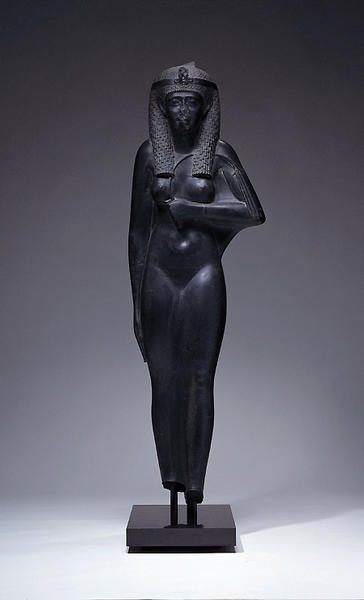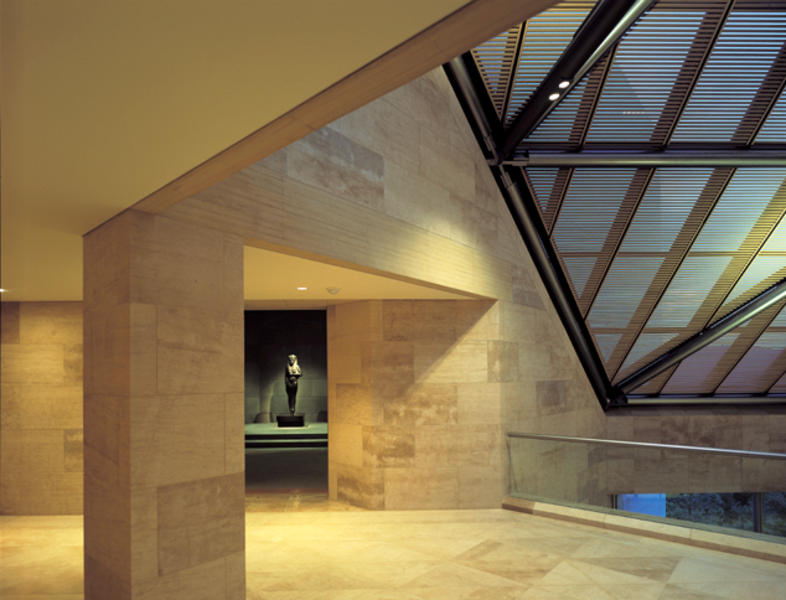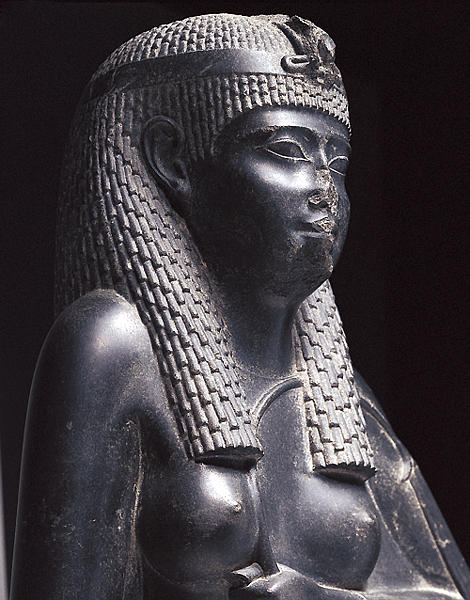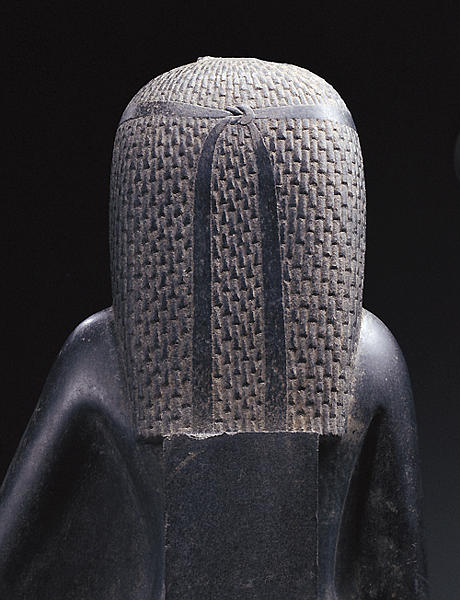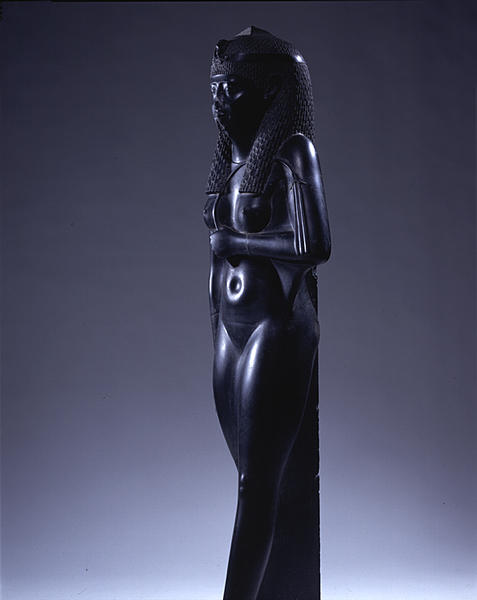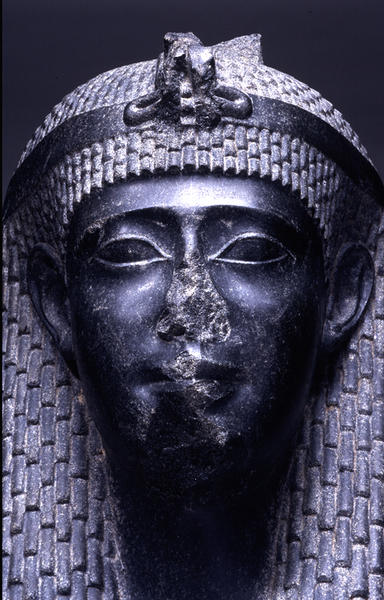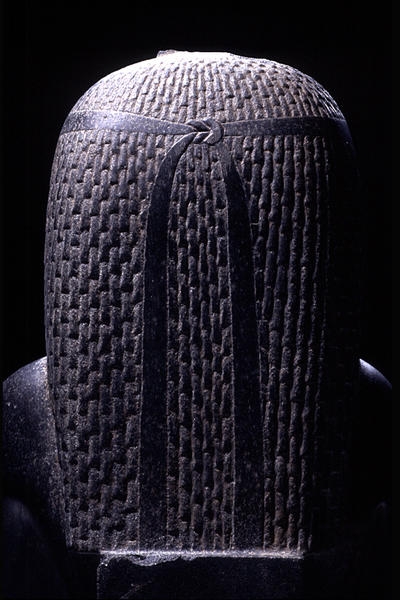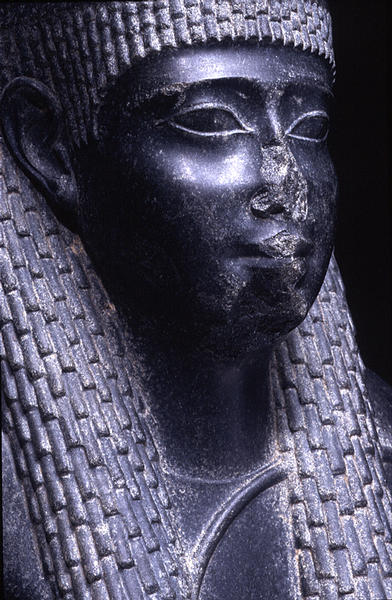女神立像
- エジプト
- プトレマイオス朝
- プトレマイオス2世期 前270-246年
- 花崗岩性閃光岩
- H-159.5 W-50
アレクサンダー後のエジプトはギリシャ人によって統治されたが、古い歴史を持つこの国の風習を取り入れ、プトレマイオス二世の王妃アルシノエ二世は愛と美の女神とされ、その死とともにエジプトの神格をも与えられた。体躯は新王国時代の風合いを持ち、頭部はこのエジプト・ヘレニズムの雰囲気を伝えている。一説にツタンカーメン王の祖母ティイの彫刻を基にして顔面を彫り直したのではないかとも言われる。
Catalogue Entry
This over-life-size portrait of the beloved but short-lived Queen Arsinoe II, wife of Ptolemy II (r. 285-246 B.C.), was almost certainly, like most of her statuary, produced posthumously. This accounts for the mask-like quality of her imagery. Her features--thin face, narrow-set eyes, straight brow-line, aquiline nose, and soft chin--are familiar from a number of portraits both in the round and in relief sculpture as well as on coins. There is no doubt about who is represented. And yet, for those who know the portraiture of Egyptian queens from earlier eras, this great statue evokes memories of previous royal wives, in particular Queen Tiy, the great wife of Amenophis III (1391-1353 B.C.), mother of Akhenaten, and perhaps grandmother of Tutankhamen.
Here Arsinoe appears as a voluptuous fertility goddess, her breasts and pubic area emphasized by deft polishing and undercutting. The Egyptian stone, her stance, and her crown, which is now missing, refer her to the first Egyptian goddess, Isis. At the time, the last centuries of the ancient era, Aphrodite, the Greek goddess of love, also began her rise to great popularity in the Mediterranean world. Thus, the Ptolemaic period in Egypt--the Hellenistic period in the Greco-Roman world--was a time when woman's undeniable role in procreation was worshipped widely and seriously. And, in fact, Isis and Aphrodite were worshipped in many locales as a single goddess.
Arsinoe is shown in the typical striding pose holding a lily scepter, the same type of scepter as she holds in a relief possibly from Memphis, now in the Harvard University Art Museums.1 There she grips it in her right hand at breast height, and it arches above and behind her right shoulder. In the Shumei statue, however, she holds the base of the scepter with her left hand at the center of her body below her breasts. The scepter circles up and around her left breast, its long, pendant beads resting against her left arm and elbow. This duplicates exactly the positioning of arm and scepter in statuary of Queen Tiy, for example on a glazed steatite figure in the Louvre.2 It is typical for Ptolemaic queens to carry attributes to one side,3 and it is standard for Queen Tiy to carry objects at the center in front of the body.4
The Shumei Arsinoe statue's left elbow juts away from her body to a distance and with an angularity uncharacteristic of both Egyptian and Greek art. It results in a large empty space below the bent arm that is out of balance with the rest of the composition. On a statue of Queen Tiy, this area would have been filled with the elder lady's large hips, buttocks, and elaborate garments. Trimming down a statue of the overripe, wide-hipped Queen Tiy to form the slim, long-waisted form of Arsinoe would have left just such a gap beneath the bent arm.
A body of evidence suggests that a statue of Queen Tiy in granodiorite of this size and in this pose once existed. First, the pose exists for Tiy, as has been shown above. Second, a series of hard black stone statues were made in this size during the reign of Amenophis III. Two remaining female figures, one of the goddess Nephthys and one of Neith, are in Paris and Marseille.5 Their faces and proportions are similar to those of Tiy. Third, granodiorite was a most favored stone for portraits of both Amenophis III and Tiy, and a number of heads of Tiy in this stone exist.
Therefore, the Shumei statue of Arsinoe probably began its life as an image of Queen Tiy and was recarved for Arsinoe II more than a thousand years later. Two methods, proportion studies and close examination of the surface of the statue, work together to bolster this suggestion.
Students of ancient Egyptian statuary are used to measuring their subjects by grid squares. Without going into unnecessary detail here, this was the method used by ancient sculptors to map out their works, and it is a useful tool for studying them today. This statue of Arsinoe measures by definition 18 grid squares from head to toe, as does the typical statue of Queen Tiy. Arsinoe measures 5.2 squares from the bottom of her foot to the top of her knee, 9.2 squares to her hips, and 16 squares to her shoulder. These are also typical measurements for Tiy. The width of Arsinoe's shoulders, 3.9 squares, and the width of her bustline, 2.7 squares, are also typical for Tiy.
Where the Shumei Arsinoe statue varies greatly from Tiy statues is at the waist and hips. Arsinoe's waist measures 2.1 squares. Tiy's waist is usually in the 2.5 to 2.9 range. Arsinoe's hips measure 3.2 squares in width. Tiy's usually range from 3.5 to 4.1 squares. This means that this statue of Arsinoe is similar to a statue of Tiy in height and in upper body width, but that the Arsinoe statue's waist and hips are narrower than Tiy's. Thus it is possible that a statue of Tiy was trimmed down in the area of the waist and hips to form the body of Arsinoe. Such trimming would account for the gap of space under Arsinoe's arm.
Close examination of the surface of the statue confirms that the hip, belly, and leg area have been severely revised.6 A wide band of abrasion, around 2.5 centimeters in width, runs down the length of the outside of the left leg. This suggests that the entire width was roughly chiseled away and then polished down in an attempt to blend it in with the overall surface. The inside of the right leg was treated similarly to bring it down to the same size. An abraded V-shape has been ground into the pubic area to emphasize the queen/goddess's aspect as a fertility deity. The width of each branch of the V is about 2.5 cm. These types of deliberate abrasions, coming in the middle of what should otherwise be completely smooth surfaces, are typical of the revisions one finds on anciently recut statuary.
The original Tiy statue would have worn a close-fitting gown, part of which would have stretched in shawl fashion over her left arm. What we now see as a web of stone beneath Arsinoe's left arm is all
